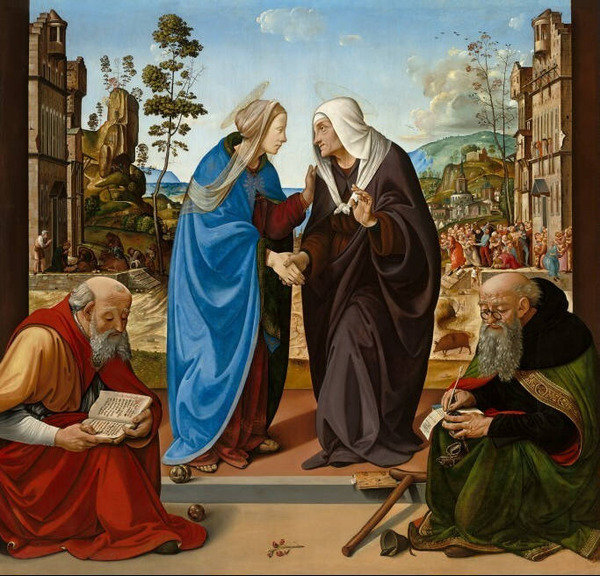Two exhibitions
dal 31/1/2015 al 1/8/2015
Segnalato da
31/1/2015
Two exhibitions
National Gallery of Art, Washington
"Piero di Cosimo: The Poetry of Painting in Renaissance Florence" features 44 of the artist's most compelling paintings. "From the Library" presents a variety of books from the late 15th through the early 17th century and explores the development of publishing related to the artistic and scholarly community in Florence.

Piero di Cosimo
The Poetry of Painting in Renaissance Florence
The first major retrospective exhibition of paintings by the imaginative Italian Renaissance master Piero di Cosimo will open at the National Gallery of Art on February 1, 2015, and remain on view through May 3, 2015. Piero di Cosimo: The Poetry of Painting in Renaissance Florence features 44 of the artist’s most compelling paintings, including fanciful mythologies, powerful religious works (one on loan for the first time from the church in Italy for which it was created 500 years ago), and sensitive portraits. Several important paintings underwent conservation treatment before the exhibition, among them the National Gallery’s Visitation altarpiece (c. 1489/1490).
From the Library: Florentine Publishing in the Renaissance presents a unique collection of texts produced between 1485 and 1637 from a number of renowned Florentine presses. On view from February 1 through August 2, 2015, in the West Building, Ground Floor, Gallery G-21, the focus exhibition is organized by the National Gallery of Art Library to complement the landmark exhibition Piero di Cosimo: The Poetry of Painting in Renaissance Florence.
The printing press revolutionized the spread of ideas and information throughout 15th-century Europe, and Florence—like Venice and Rome—was an important site for this technology. Organized into four sections that highlight the intellectual and cultural wealth of the Florentine people, the exhibition introduces Florence as an extraordinary city that supported a wide array of artistic endeavors. Highlights include first editions of Leon Battista Alberti’s seminal treatise De re aedificatoria printed in 1485 as well as Vincenzo Borghini’s 1564 account of the funeral of Michelangelo, one of only five publically available copies of this text in the United States.
Other rare examples from Florentine presses showcase a distinct relationship between text and image. A number of festival books that portray the visual experience of Florentine ceremony will be included, which shed light on the rich history of pageantry and the rise of the vernacular tradition.
Exhibition Curators
The co-curators of the exhibition are Neal Turtell, executive librarian, and Yuri Long, rare book librarian, both at the National Gallery of Art.
Organization: The exhibition is organized by the National Gallery of Art, Washington, and the Galleria degli Uffizi, Superintendency of Cultural Heritage for the City and the Museums of Florence.
Library and Rare Books Collection
The National Gallery of Art Library contains more than 400,000 books and periodicals, including more than 10,000 volumes in the rare book collection, with an emphasis on Western art from the middle ages to the present. Founded in 1941 when the West Building opened to the public, the library moved to the East Building in 1979. The photographic archives and slide library contain more than 11 million black-and-white prints and 300,000 slides of paintings, sculpture, architecture, and the decorative arts. Access to the library is by appointment only, from Monday through Friday. Call (202) 842-6511 for more information.
----------
From the Library
Florentine Publishing in the Renaissance
With neither a unified state nor even a common vernacular language among the various regions of the Italian peninsula, printing presses were established in every city and in many smaller towns. The needs of the population, the disposition of the scholarly community, and the availability of source material would have all affected local book markets. Florence was undoubtedly the cultural beacon of Europe in the Renaissance—a city with a humanist tradition dating to the late thirteenth century, where much vernacular literature originated, the scientific method was cultivated, and artistic development flourished. Surprisingly the printing press, though a catalyst for spreading these new ideas throughout Europe, took longer to catch on in this city at the heart of Tuscany, a region with an insular culture and close ties to the church. When it did, the books produced there remained mostly scholarly and religious works with little embellishment or illustration until the mid-sixteenth century.
This exhibition presents a variety of books from the late fifteenth through the early seventeenth century and explores the development of publishing related to the artistic and scholarly community in Florence. With active academic organizations and a community of highly skilled artists, Florentine scholars had a unique relationship with the more prolific Venetian presses. Though never approaching the innovation of Venice, the printers of Florence gradually established their own tradition. Theoretical treatises, literary and historical works, and festival books were all popular fare in Florence and evolved over time. Especially relevant to art history are the editions of Giorgio Vasari’s Lives, which first appeared in Florence in the sixteenth century, the material published in conjunction with Michelangelo’s funeral in 1564, and theoretical works by the likes of Leon Battista Alberti and Benedetto Varchi.
Image: Piero di Cosimo, The Visitation with Saint Nicholas and Saint Anthony Abbot c. 1489/1490 oil on panel, overall: 184.2 x 188.6 cm
Press Office
Deborah Ziska (202) 842-6353 e-mail: ds-ziska@nga.gov - pressinfo@nga.gov
The National Gallery of Art and Sculpture Garden
National Mall between 3rd and 9th Streets at Constitution Avenue NW Washington
Monday through Saturday from 10:00 a.m. to 5:00 p.m. and Sunday from 11:00 a.m. to 6:00 p.m.
The Gallery is closed on December 25 and January 1.
Free to the public



